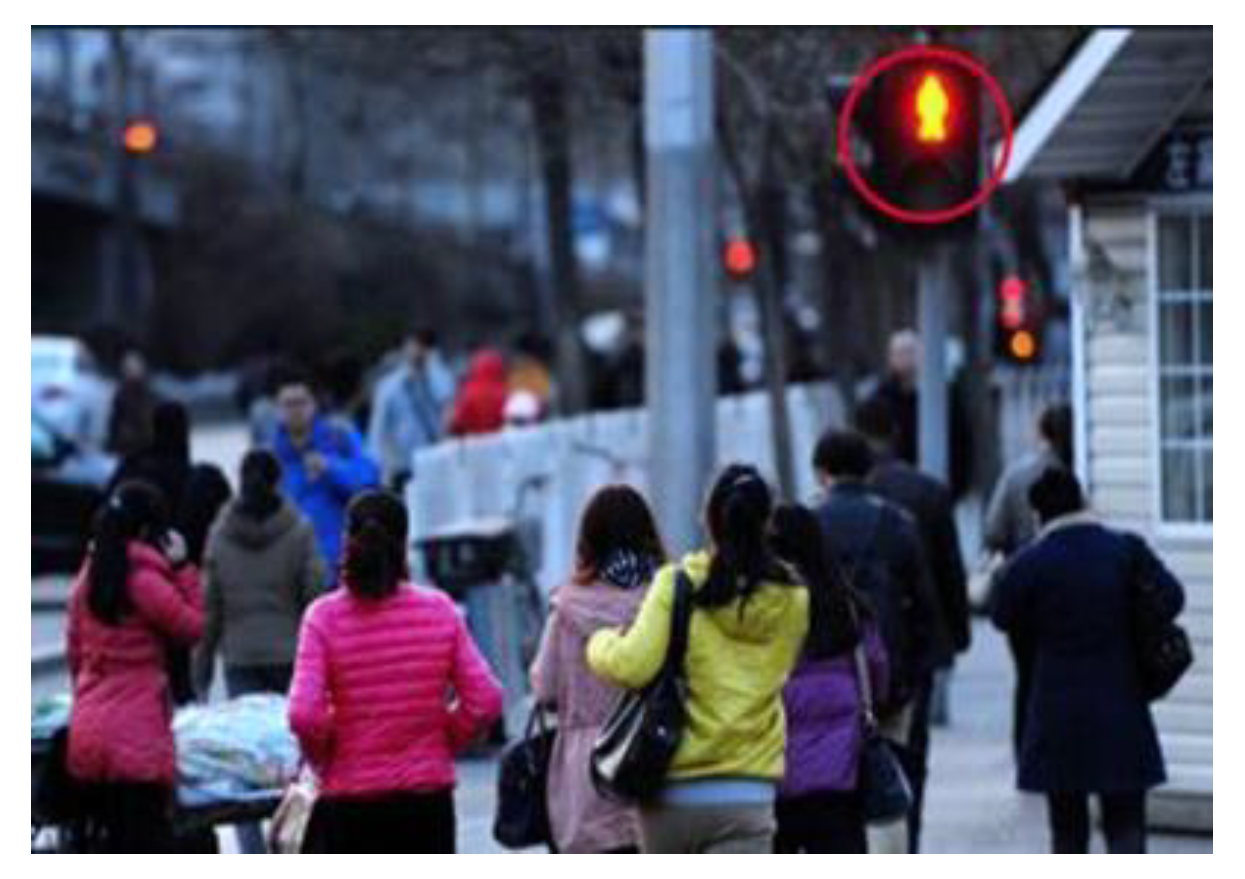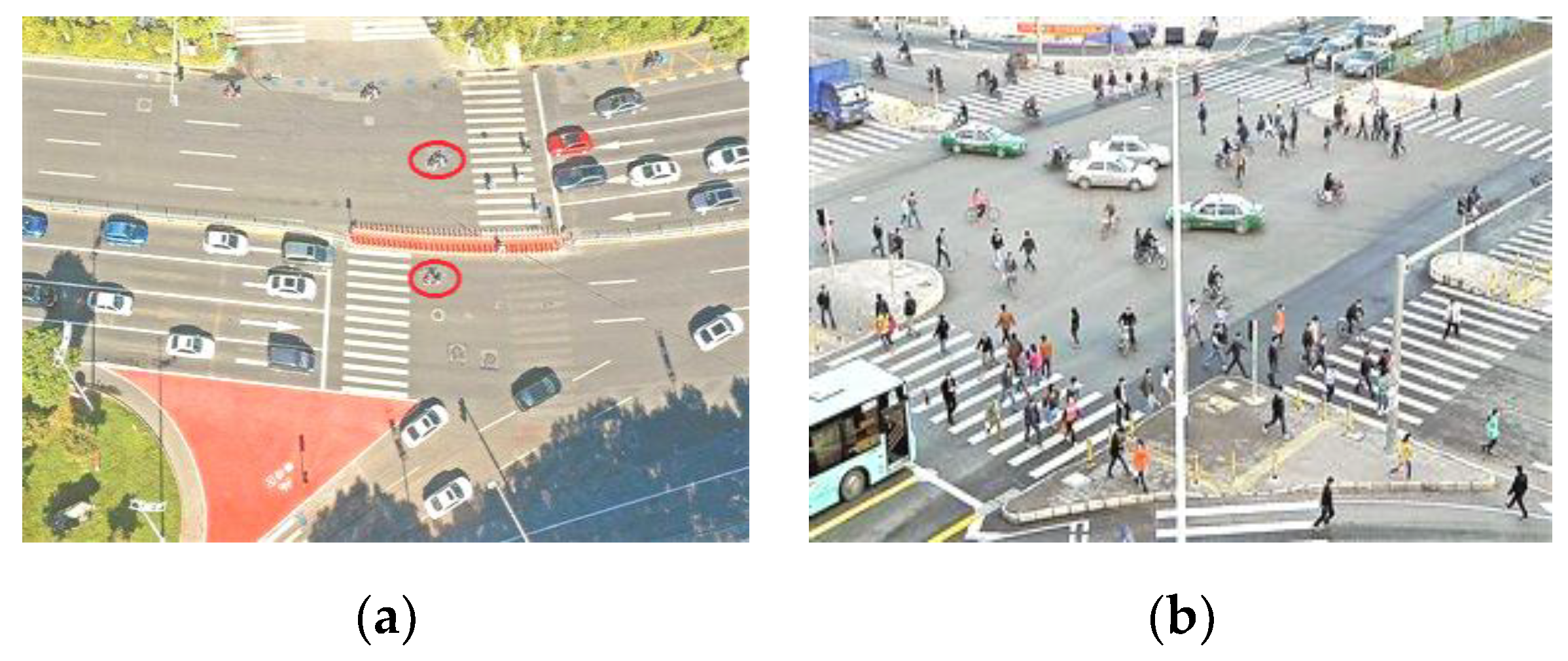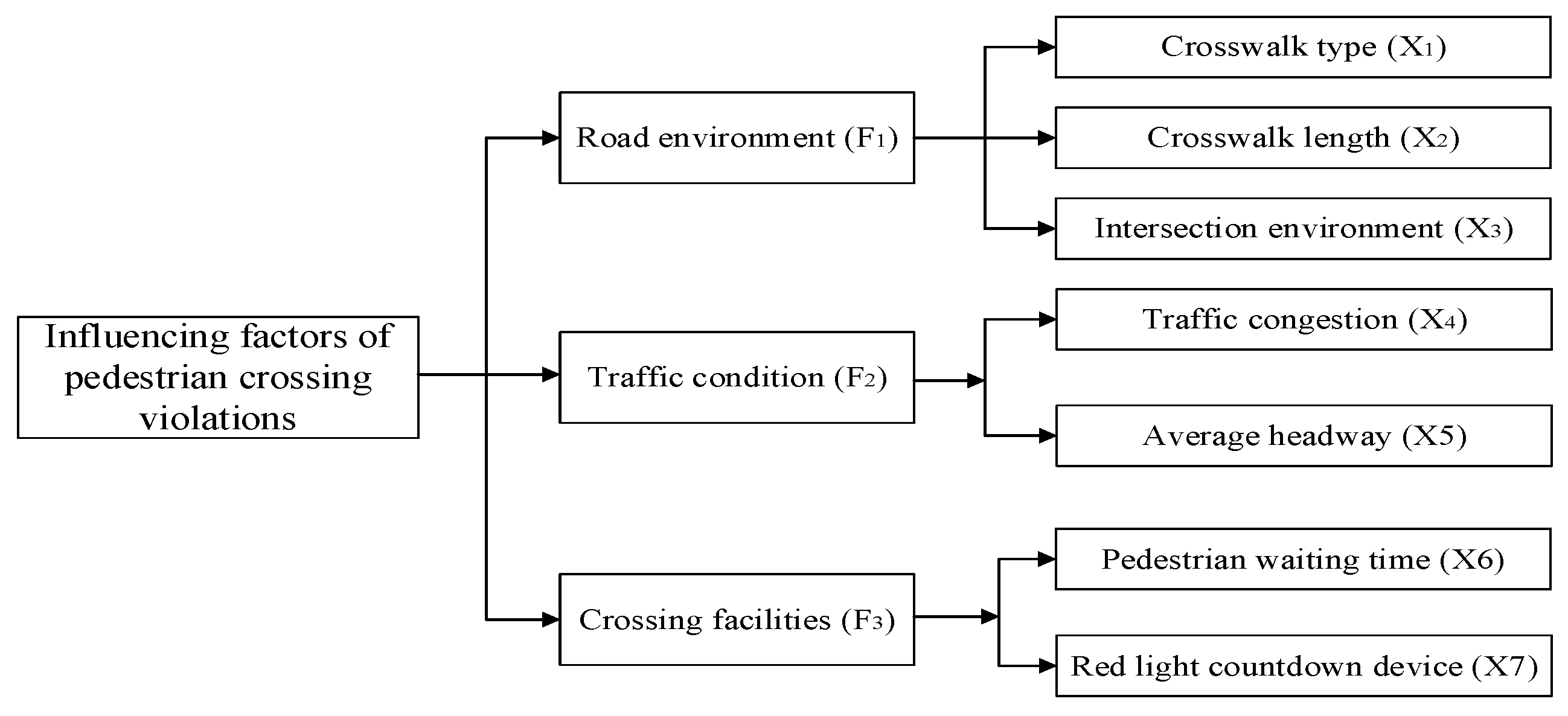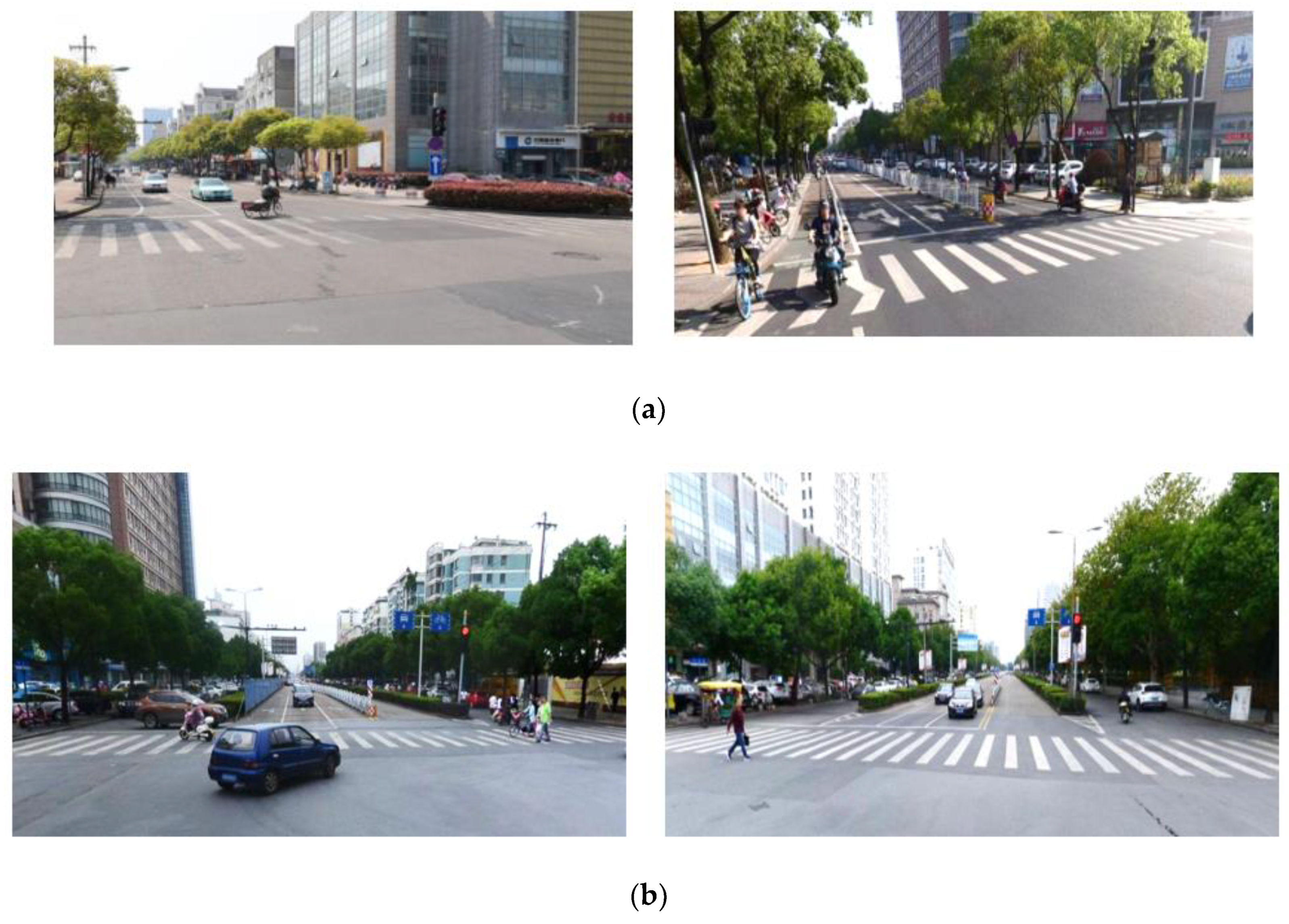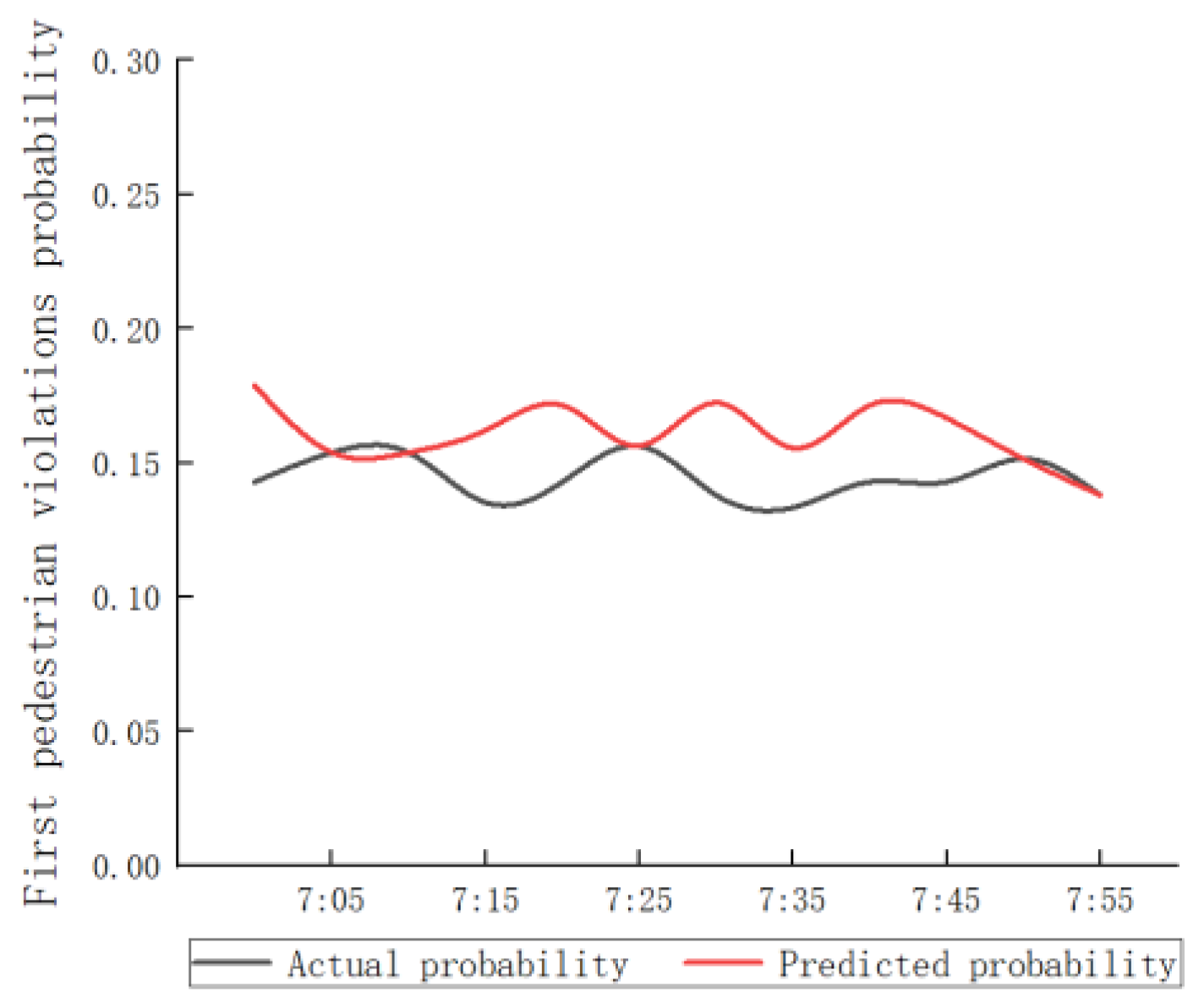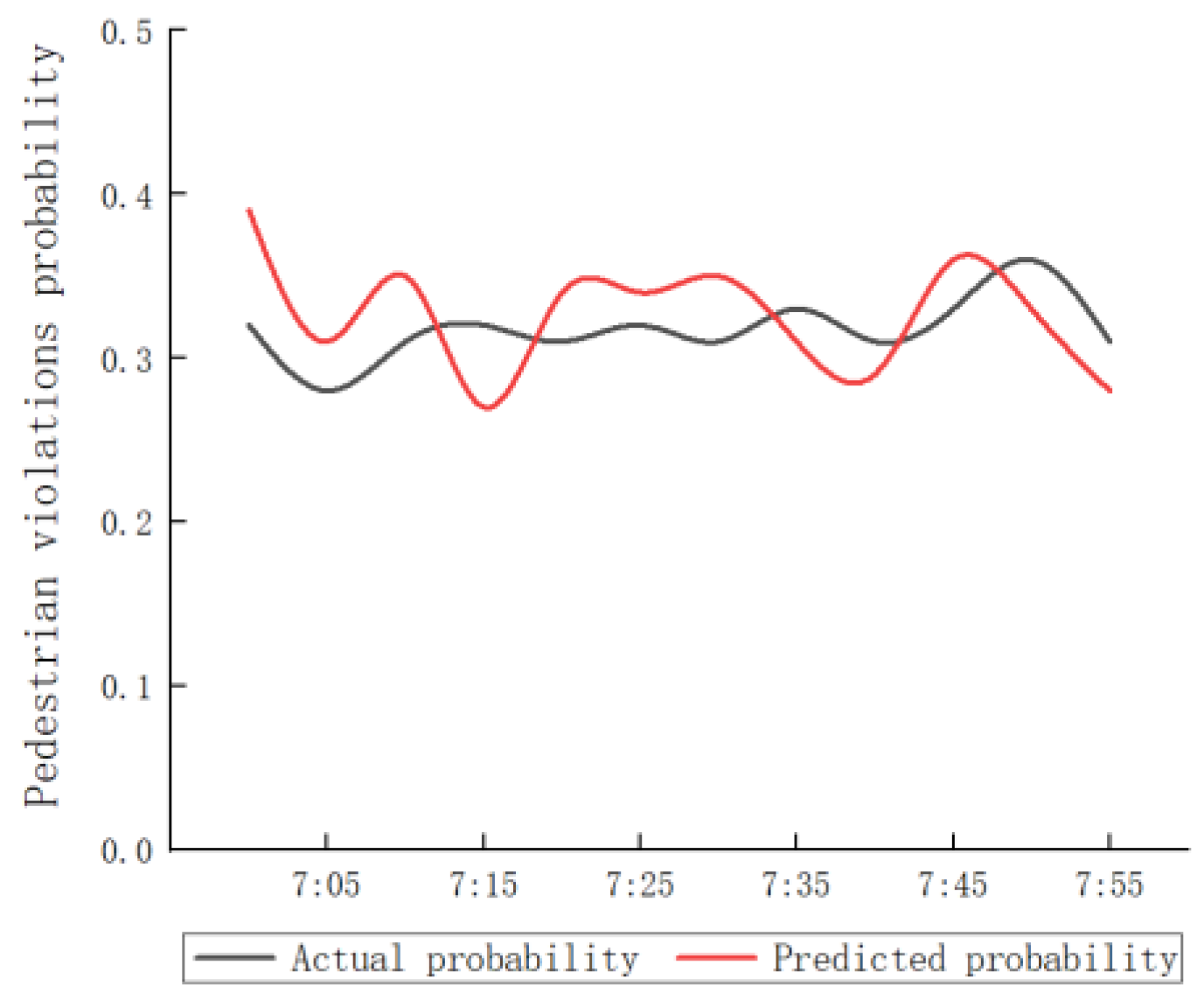3.1. Decision Model of Pedestrian Crossing Behavior Based on Logistic Regression
In order to determine whether the expected frequencies are significantly different from the observed frequencies, a goodness-of-fit test of the logistic regression model is required. In this paper, the likelihood ratio test is carried out on the frequency of the occurrence and non-occurrence of model prediction and observation events to determine whether the model is valid, where the likelihood ratio statistics approximately obey the χ
2 distribution. The so-called chi-square model χ
2 can be defined as the gap between the zero hypothesis model [
13] and the set model at
. When the chi-square model χ
2 is large, its significance is small, that is, the difference between the predicted value and the observed value is not obvious, indicating that the model can fit the data well.
where
fo is the actual observation frequency;
fe is the expected frequency.
For two-dimensional interaction tables or univariate logistic regression models, χ
2 = 0.05 is usually used as the significant level for screening candidate variables; that is, when the χ
2 significance value is less than 0.05, the independent variables are valuable for predicting the results [
14].
In
Section 2, three public factors were extracted by principal component analysis, and their variance contribution rate was as high as 80.147% through computer analysis, which can replace most information of the original seven variables. Before substituting them into the logistic model, this paper also conducts factor screening.
According to
Table 5, three independent variables of the road environment, crossing facilities, and traffic conditions all have a freedom degree of 1, and their significance is all less than 0.05, which indicates that they have a significant impact on the decision-making of crossing behavior and can be brought into the model.
When pedestrians cross the crosswalk with signalized control, there are only two kinds of decision-making behaviors: crossing in violation or crossing in compliance, which can be considered as binary variables. Therefore, this paper uses the binary logistic model to fit the data, taking whether or not pedestrians cross in violation as the dependent variable of the model, and various factor indicators as the independent variables. The model defines that the dependent variable code of pedestrian crossing is y1 = 1, and the selection probability is P1 = P; if there is a pedestrian crossing violation, the dependent variable code is y1 = 0, and the selection probability is P0 = 1-P1.
The binomial logistic regression model with K independent variables is as follows:
Therefore, the occurrence ratio of a pedestrian crossing in compliance, that is, the probability of event occurrence and the probability of event non-occurrence, is
Take the logarithm on both sides of the above formula,
After screening the independent variables, three indicators that meet the requirements of a significant level are finally selected. According to the requirements of the logistic regression model, the following regression linear equation can be obtained:
where
is the constant term;
βj is the regression coefficient of each independent variable.
The statistical software SPSS was used to calibrate the impact factor system of pedestrian crossing decision behaviors, using variables satisfying the significance level to estimate the model parameters. The final results are shown in
Table 6, where the degrees of freedom of the parameters are all 1:
According to the model estimation results, the pedestrian crossing compliance rate is
After estimating the parameters of the logistic model, deviation statistics, person χ2, and Hosmer-Lemeshow statistics were used to test the effectiveness of the influence degree of the model coefficient response.
From the data in
Table 7, when the significance level χ
2 = 0.05, the selected index variables of pedestrian crossing violations can well fit the data, so the independent variable index of the model has a significant explanatory ability for the dependent variable.
3.2. Probability Model of Following Pedestrian Violations Based on a Markov Chain
Many researchers focus on intersection crossing behavior using, e.g., the survey statistics method [
15,
16], the micro-simulation analysis method [
17,
18], the survival analysis method [
19,
20], the discrete choice method [
21,
22], and so on. Relevant studies have carried out in-depth analyses on the maximum time pedestrians will wait to cross the street, the delay caused by pedestrians crossing the street, and the traffic characteristics of speed, and have constructed models adapted to specific conditions. However, they fail to reflect the inherent following psychology and dynamic change process of pedestrians when crossing the street in a time series.
In this paper, the decision-making behavior of pedestrian crossing is divided into countable t states based on minutes. The time and state obtained are discrete, which conforms to the definition of a Markov chain. Therefore, the probability vector S(j) is constructed to represent the decision-making state of pedestrians in the
j-th cycle:
where S
t(j) (t = 1, 2, 3) represents the probability of being in state t during period j.
Other variables are defined as follows:
n is the number of pedestrians counted by the survey sample; Ai is the decision-making behavior sequence of the i-th pedestrian in the selected period, where Ai1 represents the behavior sequence of pedestrians crossing the street in compliance, Ai2 represents the behavior sequence of pedestrians crossing the street in violation, Ai3 represents the behavior sequence of pedestrians following the previous violation, where 1 ≤ I ≤ n.
In order to judge whether the decision-making sequence of pedestrian behavior conforms to the definition of a Markov chain, that is, the state of the random variable X(
n+1) only depends on the current state of X(
n), and is independent of the state of the previous random variable [
23,
24], the χ
2 statistic can be used to test the “Markov property” of the discrete sequence [
25]:
Suppose
is a sequence of index values containing m states in the number of decision-making behaviors, using
fij to represent the frequency of a one-step transition from state
i to state
j in the sequence. The marginal probability
pj denotes the sum of the
j-th column of the state transition frequency matrix F divided by the sum of each row and column of the matrix.
When
n tends to be large enough, the χ
2 statistic is
which satisfies the χ
2 distribution with freedom degrees (m − 1)
2, where
pij is the transition probability from state
i to state
j.
Under the given significance level α, if the statistic χ
2 satisfies
it shows that the decision sequence of crossing behavior has a “Markov property”. At this time, the k-step transition probability of Markov chain at time
n is
Suppose that the probability vector of a pedestrian’s initial crossing state is
and, after
k-step transition, the value is
, that is, the selection behavior of pedestrian crossing after k cycles. In period
k, the probability of pedestrian crossing in state
t is
, and the transition probability matrix P of pedestrian crossing decision behavior state is
According to the ergodicity of the Markov chain, the probability of the process in state j is stable to
after an infinite time from any state
. When
, the state probability S(k) will be infinitely close to a certain value, that is, as the transition step length gradually expands, the pedestrian’s decision-making state will tend to be stable. In the steady state, the probabilities of the two decision states can be expressed by
:
Since the statistical time series contains multiple statistical moments, the mean absolute error (MAE) and mean absolute percentage error (MAPE) can be used as evaluation indicators [
26]. According to the relevant references, the smaller the values of these two errors are, the more accurate the prediction results are, and the stronger the matching degree is:
where
is the predicted value; qs is the actual value.
